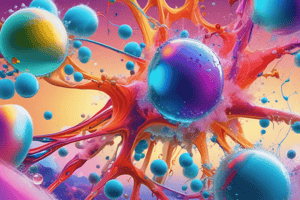Podcast
Questions and Answers
What defines the shape and volume of a solid?
What defines the shape and volume of a solid?
- Particles are closely packed in a fixed arrangement. (correct)
- Particles are loosely packed and move freely.
- Particles have no defined arrangement and are highly compressible.
- Particles are far apart and move rapidly.
Which of the following is not a characteristic of liquids?
Which of the following is not a characteristic of liquids?
- Particles can move past one another.
- Defined volume.
- Rigid structure. (correct)
- Takes the shape of the container.
What happens to solids when temperature increases?
What happens to solids when temperature increases?
- They melt into liquid. (correct)
- They freeze into liquid.
- They condense into gas.
- They sublimate into gas.
Which statement best describes gas?
Which statement best describes gas?
Which process occurs when a solid turns directly into a gas?
Which process occurs when a solid turns directly into a gas?
What is the main factor that influences the state of matter?
What is the main factor that influences the state of matter?
What defines the compressibility of gas compared to solids and liquids?
What defines the compressibility of gas compared to solids and liquids?
Which of the following examples is a solid?
Which of the following examples is a solid?
During which process does liquid turn into gas?
During which process does liquid turn into gas?
Flashcards are hidden until you start studying
Study Notes
Three States of Matter
-
Solid
- Defined shape and volume.
- Particles are closely packed together in a fixed arrangement.
- Particles vibrate but do not move past each other, resulting in rigidity.
- Examples: Ice, wood, metal.
-
Liquid
- Defined volume but takes the shape of the container.
- Particles are close together but can move past one another, allowing flow.
- Less compressible than solids and gases.
- Examples: Water, oil, alcohol.
-
Gas
- No defined shape or volume; expands to fill the container.
- Particles are far apart and move freely and rapidly.
- Highly compressible compared to solids and liquids.
- Examples: Oxygen, carbon dioxide, helium.
Key Properties
- Matter: Anything that has mass and occupies space.
- Phase Changes: Matter can change from one state to another through processes such as melting (solid to liquid), freezing (liquid to solid), evaporation (liquid to gas), condensation (gas to liquid), sublimation (solid to gas), and deposition (gas to solid).
- Temperature and Pressure: Conditions that can affect the state of matter; for example, increasing temperature can turn solids into liquids (melting) or liquids into gases (evaporation).
Summary
- Matter exists predominantly in three states: solid, liquid, and gas, each with distinct properties and behaviors.
- The transitions between these states are influenced by temperature and pressure.
Three States of Matter
- Solid: Has a definite shape and volume; particles are tightly packed and vibrate in place without moving past one another, contributing to its rigidity.
- Liquid: Has a definite volume but adopts the shape of its container; particles are close together yet can slide past one another, enabling fluidity and reducing compressibility compared to solids.
- Gas: Lacks a defined shape or volume; particles are widely spaced, moving rapidly and freely, allowing gases to expand and fill their container. Highly compressible compared to solids and liquids.
Key Properties
- Matter: Defined as anything with mass and volume, encompassing all forms of physical substances.
- Phase Changes: Matter can transition between states through processes such as:
- Melting: solid to liquid
- Freezing: liquid to solid
- Evaporation: liquid to gas
- Condensation: gas to liquid
- Sublimation: solid to gas
- Deposition: gas to solid
- Temperature and Pressure: Crucial factors that affect the states of matter; higher temperature can induce melting or evaporation, while changes in pressure may influence phase transitions.
Summary
- Matter primarily exists in three states: solid, liquid, and gas, each characterized by unique properties and behaviors.
- The alterations among states are primarily driven by variations in temperature and pressure.
Studying That Suits You
Use AI to generate personalized quizzes and flashcards to suit your learning preferences.




